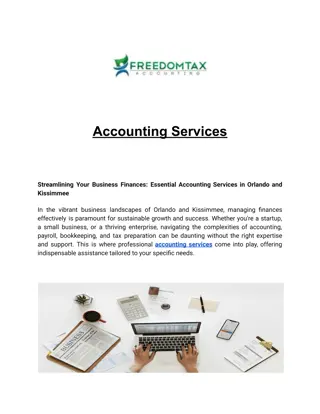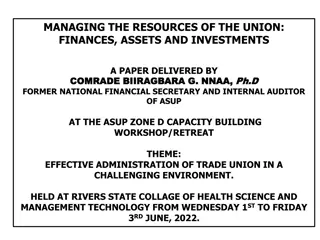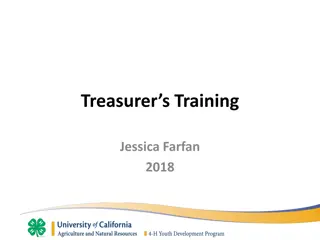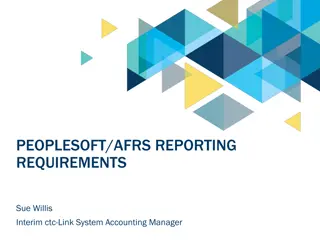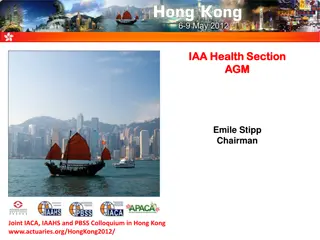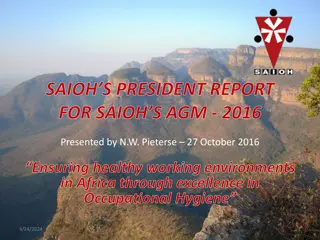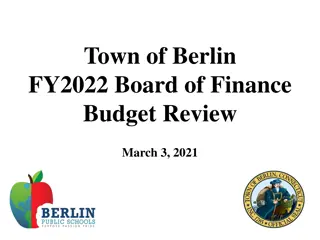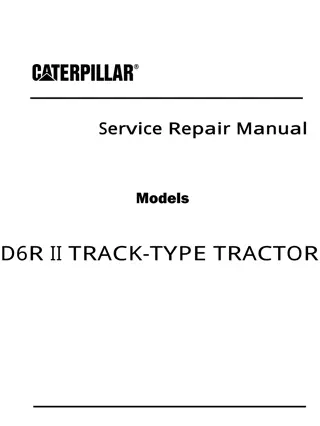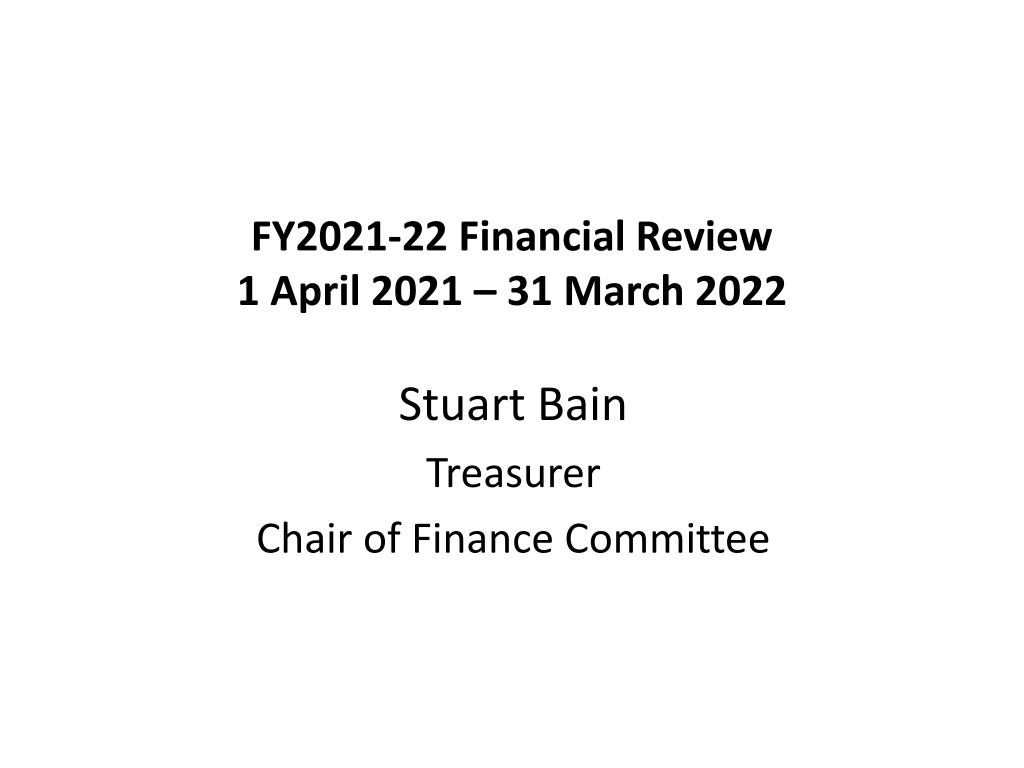
Key Financial Insights for FY2021-22 at WTSWW
Explore the financial review for FY2021-22 conducted by Stuart Bain, focusing on key issues, sources of income, changes in funding, and the impact of Covid-19 recovery efforts at WTSWW. Discover the vital role of grants, donations, trading activities, and more in sustaining the organization's operations.
Download Presentation

Please find below an Image/Link to download the presentation.
The content on the website is provided AS IS for your information and personal use only. It may not be sold, licensed, or shared on other websites without obtaining consent from the author. If you encounter any issues during the download, it is possible that the publisher has removed the file from their server.
You are allowed to download the files provided on this website for personal or commercial use, subject to the condition that they are used lawfully. All files are the property of their respective owners.
The content on the website is provided AS IS for your information and personal use only. It may not be sold, licensed, or shared on other websites without obtaining consent from the author.
E N D
Presentation Transcript
FY2021-22 Financial Review 1 April 2021 31 March 2022 Stuart Bain Treasurer Chair of Finance Committee
WTSWW key financial issues Finance Committee reports to the Board of Trustees Meets quarterly to monitor finances, support CEO and senior management team Regular areas of focus remain performance vs budget, potential expenditure on new reserves and other assets, pensions, investments, and Trust liabilities In FY2022 the Committee s focus has been dominated by: Covid-19 Recovery: Managing the start of a recovery from Covid-19, trying to maximise visitors to our reserves (and their associated income) during the summer. Resourcing: Addressing significant reductions in availability of potential new staff, especially for our retail/visitor facilities. Funding: Continued bidding for funding from a variety of sources, including government/local government, grant-giving institutions, and individuals Conservation costs: Maximizing the stability of long-term key conservation work, as well as dealing with Ash Die-Back
WTSWW in FY2022: where did our income come from? WTSWW income by area FY2021-22 Other income, 120,786, 5% Covid-19 Job Retention Scheme (=furlough), 3,767, 0% Investment Income, 55,509, 2% Member subscriptions, 297,140, 13% Income derived from Nature Reserves, 267,257, 11% Donations & Gifts, 157,881, 7% Legacies, 105,196, 4% Grants, 683,854, 29% Trading activities, 545,669, 23% Fundraising income, 142,564, 6%
(More) big changes in the sources of our operating income WTSWW sources of income FY2022 vs FY2021 1,600,000 We benefitted from major grants to help with the effects of Covid-19 in FY2021: these did not recur in FY2022 1,400,000 FY2021 1,200,000 FY2022 1,000,000 A return of visitors to our nature reserves drove welcome rebounds in trading income 800,000 Furlough support ended, but we benefitted from a one-off 100,000 insurance payment covering our losses during the pandemic 600,000 400,000 200,000 0
Emergency grants were vital during Covid-19. WTSWW grant income FY2005-2022, 2,400,000 other grants (mainly < 10k) 2,000,000 Wildlife Trusts Landfill, Co-op bags & other environmental levies 1,600,000 Lottery, PPL & other 1,200,000 Charitable foundations 800,000 European grants Other Welsh & local government-related 400,000 NRW & predecessor bodies - 2005 2006 2007 2008 2009 2010 2011 2012 2013 2014 2015 2016 2017 2018 2019 2020 2021 2022
A recovery in trading income is vital for our charitable work DWT income and profit/loss since FY 2006 700,000 600,000 DWT income 500,000 400,000 Profit/(loss) before taxation, as reported 300,000 DWT had achieved an average 93k annual surplus FY2014-2020 200,000 PBT adding back management charges/rents payable to WTSWW 100,000 0 20062007200820092010201120122013201420152016201720182019202020212022 - 100,000
In FY2022 we still spent c.60% of our net charitable income directly on conservation and education . WTSWW expenditures as % income, FY2003-2022 Year to end-March 120% Skomer reconstruction 100% Changed allocations under SORP 2015: not fully comparable with prior years Nature conservation & education, as % of "net charitable income" (= similar to RSPB; average = 62% ex- Skomer) 80% 60% Nature conservation & education, as reported (average = 49% ex-Skomer) 40% Support & governance costs (average = 11% since FY10) 20% 0% 2003 2004 2005 2006 2007 2008 2009 2010 2011 2012 2013 2014 2015 2016 2017 2018 2019 2020
. But our staff have continued to fund some of the costs of the Trust Our staff numbers were unchanged in FY2022, but our average salary fell fractionally Full-time equivalents 55 25,000 50 Conservation & education 45 20,000 40 Trading 35 15,000 Fundraising & membership 30 25 10,000 Administration 20 15 Average staff cost (RHS) 5,000 10 5 0 0 2009 2010 2011 2012 2013 2014 2015 2016 2017 2018 2019 2020 2021
Conclusions, and looking into 2023 WTSWW sources of income were, pre-Covid-19, diversified and very well balanced A mix of visitor income, grants, trading, and membership subscriptions We are continuing to return to a better balance of income in the future We ended FY2022 with another good surplus But our visibility of some sources of funding, especially grants, remain low. And inflation, as well as the resources needed to manage our large estate, remain significant pressures




